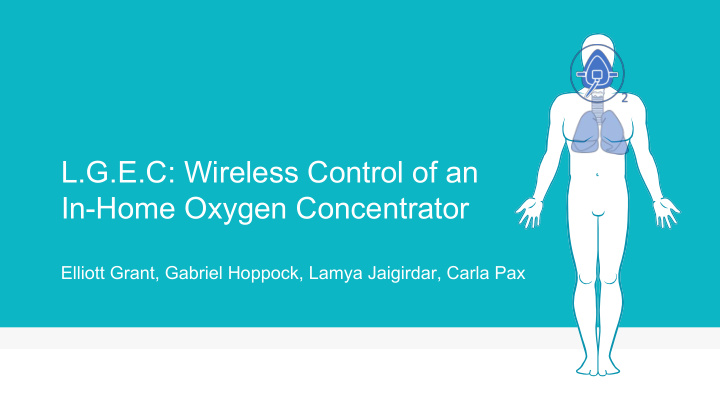



L.G.E.C: Wireless Control of an In-Home Oxygen Concentrator Elliott Grant, Gabriel Hoppock, Lamya Jaigirdar, Carla Pax
2 THE DISEASE: IDIOPATHIC PULMONARY FIBROSIS (IPF) IPF Lung Healthy Lung IPF is a chronic illness ● The tissue in the lungs to thicken and scar ● The rate of oxygen transfer in the lungs is decreased ● IPF patients require Long-Term Oxygen Therapy ● (LTOT)
3 Oxygen Concentrator
4 THE DISEASE: IDIOPATHIC PULMONARY FIBROSIS (IPF) Initial target market: ● U.S. Oxygen Therapy Market Size (USD Billion) 110,000 individuals in the U.S. ● Lifespan: ● 3 to 5 years ● Increase in geriatric population ● leads to increase in IPF patients
5 THE PROBLEM: Different oxygen liter flow rates are needed for each physical activity, but there is no continuous access to the oxygen concentrator to change the flow.
6 THE PROBLEM: Incorrect O2 Levels have adverse side effects LOW OXYGEN HIGH OXYGEN LEVELS LEVELS Coughing Stripping of the nasal cavity ● ● Fatigue Headaches/Disorientation ● ● Shortness of Breath Myopia ● ● Chest Pain CO2 Narcosis ● ●
7 IPF Patient Visit Lack of knowledge of IPF flow rate requirements ▹ Negative perception of being “Addicted to Oxygen” ▹ Inconsistency-Patient claims flow rate was 3 L/min when actually 2.5 L/min ▹ Lack of easy communication with doctors ▹ Never changes oxygen liter flow rate until the patient feels ill ▹ Physical activity is limited to sitting, eating, television, sleeping, puzzles ▹ Lack of easy way track and store health information ▹ General frustration and confusion regarding the treatment and illness ▹
8 IPF Patient Visit
9 Needs Assessment L.G.E.C is seeking an inexpensive and novel way to 1. Wirelessly control the oxygen liter flow on the oxygen concentrator 2. Noninvasively monitor oxygen needs of IPF patients 3. Inform the specific patient on what their oxygen liter flow should be based on their oxygen requirement 4. Provide the user a way to monitor and track their oxygen liter flow
10 Goal:
11 Design And Application Requirements Accuracy Safety - Based on clinical protocol - Clinically tested on patients - Able to be calibrated Ease of Implementation - Intuitive to use - Easy to connect device and website
12 Device Requirements: Safety Will not decrease patient’s Will use a direct power respiratory function source Have back-up battery capability in Adjust oxygen liter flow based on case of emergencies patient’s health condition
13 Device Requirements: Cost Efficiency and Ease of Implementation Cost Efficiency - Should have low manufacturing costs by using inexpensive materials Ease of Implementation - Must be able to connect to a standard outlet - Should be easy to install, remove, and set-up
14 What will our device do? Physically change oxygen liter flow by ● rotating the knob Bluetooth enabled to wirelessly ● communicate with the application Adjustable and easily attachable ●
15 Device Design
16 Device Design
17 Circuit Diagram
Application Requirements Effective Ease of Navigation - Explain how the application - Adjustable font sizes works - Provide instructions on how to - Allow user to track O2 saturation use application and liter flow requirement Secure Ease of Implementation - Collect user info into separate - Free to download accounts - Compatible with all Android - Require authentication to devices on all software versions access a user account
19 Front End Design Step 1: Step 2: Option 1: Log-In Option 1: Adjust Your Device Option 1a: Input blood O2 saturation level Enter: email and/or phone # and password Option 2a: Manually input desired oxygen liter flow rate Option 2: Create a New Account Option 2: Access Your Account Option 2a: View O2 saturation values overtime classified by Enter: name, email, phone, age, birthday, gender, baseline activity level and O2 liter flow rate O2 liter flow rate, password, re enter password Option 3b: Edit your account information Option 3: Settings Option 3a: Choose your oxygen concentrator Option 3b: Adjust font size Option 3c: Log out Option 4: Help Option 4a: How to Use this Application? Option 4b: How this Application Works?
20 Front End Design This was created using ● open-source Android app code in Java powered by MIT
21 Protocol: How O2 Liter Flow Rate Changes with O2 Saturation Levels
22 Future Steps Add more application functionality ● Clinically test our system ● Incorporate IR technology on Android Devices ● Create customizable features ● Explore funding options ●
23 THANK YOU! Any questions? You can contact us at https://my.vanderbilt.edu/lgecseniordesign2018/ ▹
24 References 1. Reference, G. H. (n.d.). Idiopathic pulmonary fibrosis. Retrieved April 10, 2019, from Genetics Home Reference website: https://ghr.nlm.nih.gov/condition/idiopathic-pulmonary-fibrosis 2. EY, B. AND COLLARD, H., 2013. Epidemiology of idiopathic pulmonary fibrosis. Dove Medical Press, 5, 483-492. 3. Radswiki. (n.d.). Idiopathic pulmonary fibrosis | Radiology Case | Radiopaedia.org. Retrieved April 18, 2019, 4. Oxygen Therapy Market Size, Share | Global Industry Report 2018-2024. (n.d.). Retrieved April 18, 2019 5. How Do Oxygen Concentrators Work? (n.d.). Retrieved April 18, 2019, from https://www.1stclassmed.com/oxygen-concentrators-work
Recommend
More recommend